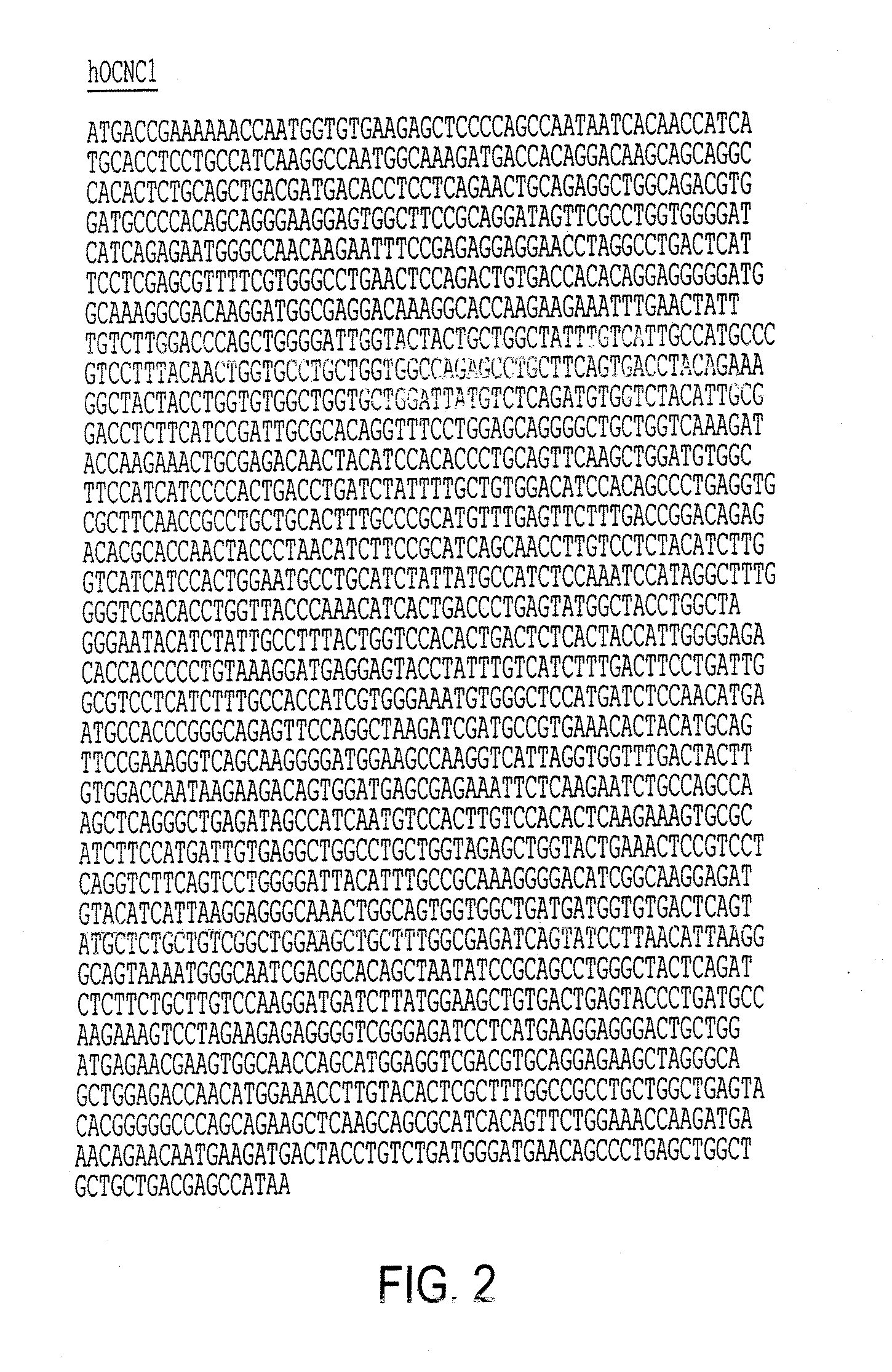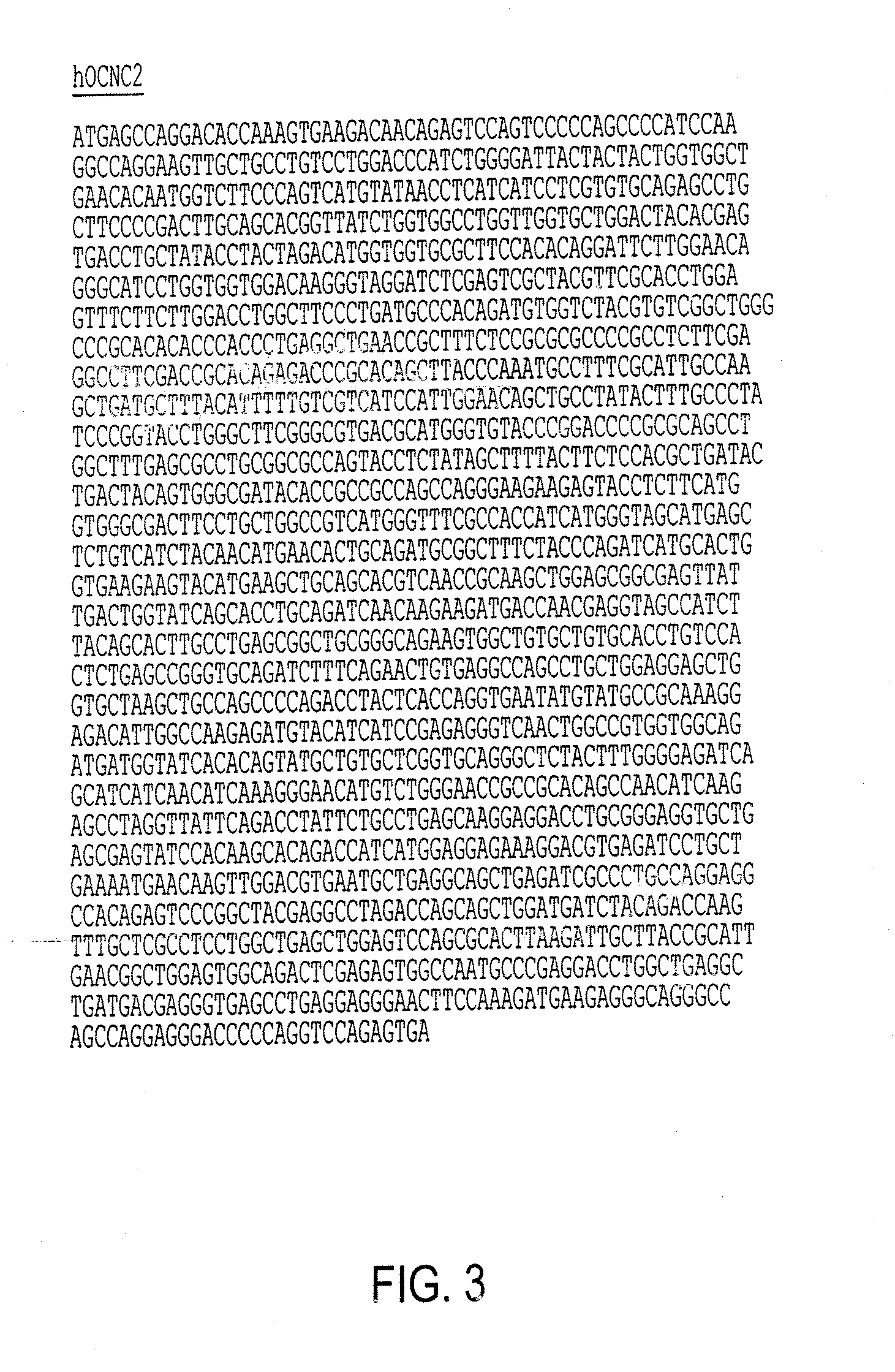Expression of functional human olfactory cyclic nucleotide gated (CNG) channel in recombinant host cells and use thereof in cell based assays to identify smell modulators
a technology of cyclic nucleotide gated and which is applied in the field of expression of functional human olfactory cyclic nucleotide gated (cng) channel in recombinant host cells and cell based assays to identify smell modulators, can solve the problem that the high-throughput screening of electrochemical assays is not feasibl
- Summary
- Abstract
- Description
- Claims
- Application Information
AI Technical Summary
Benefits of technology
Problems solved by technology
Method used
Image
Examples
example 1
Cloning Human Olfactory CNG Channel Subunits
[0185]Prior to this invention, the sequences of the human olfactory CNG channel subunits were not known. Electrophysiological analysis of human olfactory neurons, however, suggested a functional similarity to the rat channel (Thurauf et al., 1996), and we identified orthologs of the three rat subunits in the human DNA databank (FIGS. 1-4). We established the presence of OCNC1 and OCNC2 in human olfactory epithelial mRNA by RT-PCR, and the full-length cDNAs for these two subunits were cloned by a combination of PCR from commercially available cDNA and PCR amplification of 5′ coding exons from genomic DNA. Terminal 5′ AscI and 3′ NotI sites were added flanking the human OCNC1 coding sequence, and the OCNC1 AscI-NotI fragment was cloned into the pEAK10 expression vector (Edge Biosystems) to produce plasmid SAV1931. The 5′ AscI site incorporated a 3 nucleotide linker sequence to introduce an optimized translation initiation site: GGCGCGCCgccAT...
example 2
Developing a High-Throughput Assay Platform for the Human Olfactory CNG Channel
[0187]HEK-293T cells were transiently transfected with cloned human olfactory CNG channel subunits using lipid-based protocols. Transfection efficiencies, which were monitored by cotransfection of an RFP expression vector, were typically greater than 70%. After 24 hours, cells were harvested and transferred to 96 well plates. After an additional 24 hours, cells were loaded with either a fluorescent calcium or membrane potential dye for one hour, washed, and transferred to a FLIPR automated fluorometric plate reader with on-board fluidics.
[0188]In contrast to mock-transfected cells, cells transfected with olfactory CNG channel subunits displayed increased fluorescence following forskolin stimulation. Moreover, the magnitude of the forskolin response was subunit dependent: OCNC1 alone produced an active CNG channel, and OCNC2 (to a lesser extent) and β1b (to a greater extent) potentiated OCNC1 activity (FIG...
example 3
Developing a CNG Channel-Based Fluorescence Assay for GPCRs
[0189]Rich et al. (2001) constructed and characterized a mutant form of the rat OCNC1 CNG channel that has increased cAMP sensitivity. We generated the corresponding hOCNC1 [C460W / E583M] mutant (SEQ ID NO: 4)—carried in plasmid SAV2480—and found that in combination with β1b it has increased cAMP sensitivity and robust activity (FIG. 8). This increased sensitivity suggested that this human olfactory CNG channel variant might function as a cAMP biosensor and allow the development of whole cell-based fluorescence assays for GPCRs and other proteins that regulate cAMP levels.
[0190]HEK-293 cells were transfected with OCNC1[C458W / E581FM], OCNC2, and β1b and a mouse olfactory receptor, mOREG, that is activated by eugenol (Kajiya et al., 2001). Transfected cells were seeded onto multi-well plates. After 48 hours, cells were loaded with a calcium dye for one hour, then washed, and their response to eugenol stimulation was monitored b...
PUM
| Property | Measurement | Unit |
|---|---|---|
| molecular weight | aaaaa | aaaaa |
| molecular weight | aaaaa | aaaaa |
| molecular weight | aaaaa | aaaaa |
Abstract
Description
Claims
Application Information
 Login to View More
Login to View More - R&D
- Intellectual Property
- Life Sciences
- Materials
- Tech Scout
- Unparalleled Data Quality
- Higher Quality Content
- 60% Fewer Hallucinations
Browse by: Latest US Patents, China's latest patents, Technical Efficacy Thesaurus, Application Domain, Technology Topic, Popular Technical Reports.
© 2025 PatSnap. All rights reserved.Legal|Privacy policy|Modern Slavery Act Transparency Statement|Sitemap|About US| Contact US: help@patsnap.com



